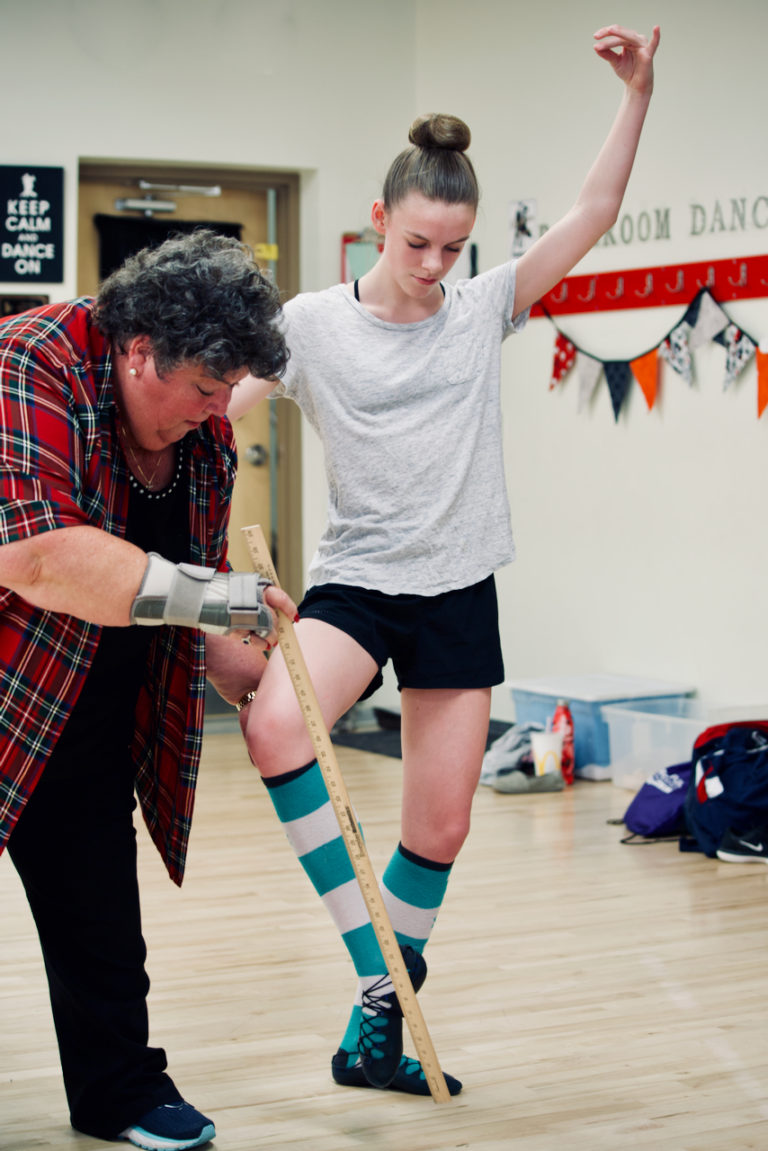- The judges mark each dancer out of 100 with first place going to the dancer(s) with the highest score, and so on down the line. 0 for a disqualification to 100 for a perfect dance, though 100 is extremely rare.
- Judges points are used only to determine what place each dancer receives for each dance.
- Aggregate winners are determined by adding up the combined scores over the day, but rather than use the judge’s scores, points are assigned according to placement (Dance Points).
- All competitions run under the Scottish Official Board of Highland Dancing use the same schedule of points, keeping the job of scoring consistent from one competition to another.
NEW DANCERS
Growth, Enjoyment, Friendships and Celebrating the Scottish Spirit.

A Little Background
Highland dance developed in the Scottish Highlands in the 19th and 20th centuries as a form of competition at public events such as the Highland games. It was created from the Gaelic folk dance but formalized using elements of ballet.
For more information and a great read on the history of Highland Dance, visit the site: Historic-UK.com.
- Highland dancing was traditionally performed by men but is now performed by both men and women. It is one of few areas where men and women compete equally.
- In competition, Highland dances are generally danced solo, but duet and group Choreography categories in competitions are becoming more common.
- Dancers typically dance to traditional Scottish music all played by an accompanying bagpiper.
- The dances are made up of different parts, called steps and there are usually four or six steps to a dance.
- The dances are great fun and anyone, not just those with a Scottish heritage, can join in and learn the dances.
Benefits of Highland Dance
A skillful and technical dance form, providing dancers a wealth of benefits.
Here’s just a few…
Choosing the Right Teacher
Teachers should be members of the SOBHD, BATD, and/or MWHDA ;). They should be able to produce a current membership card. Other than the obvious questions regarding location, costs and class schedules, you may want to ask a prospective teacher about things like:
- Class sizes and composition (age and ability)
- Whether or not a parent can observe the class
- Any concerns about the competitive aspects
- If medal tests are done each year
- Choreography, if that interests you
- Performances or events
- What length of commitment is required initially
- The competitive achievements of the teacher and his/her students
- Expectations they have of their students (practicing, attending performances, competitions)
Competition Levels
00 Primary
01 Beginner
02 Novice
03 Intermediate
04 Premier
00 Primary
Primary
For dancers 6 years and under
Competitors are not permitted to register until the age of 4 but if they are under seven years of age they may compete as a Primary dancer until their seventh birthday is reached after which the competitor is classified as a Beginner.
Dances:
— Pas De Basque (pronounced ‘paw-de-baa’)
— Pas De Basque and Highcuts
— Fling
— Sword
01 Beginner
Beginner
For newly registered dancers 7 years and over
Beginners have six squares to be marked on the back of their dance card. This is done by placing 1st, 2nd or 3rd at six different competitions in any HIGHLAND dance. When this is done the dancer moves to Novice.
Dances:
— Fling
— Swords
— Seann Truibhas
— Strathspey and Highland Reel
— Reel of Tulloch (rarely)
— Scottish Lilt
— Flora McDonalds Fancy
02 Novice
Novice
For dancers 7 years and over
Novices have six squares to be marked on the back of their dance card. This is done by placing 1st, 2nd or 3rd at six different competitions in any dance. When this is done the dancer moves to Intermediate.
Dances (same as beginner):
— Fling
— Swords
— Seann Truibhas
— Strathspey and Highland Reel
— Reel of Tulloch (rarely)
— Scottish Lilt
— Flora McDonalds Fancy
03 Intermediate
Intermediate
For dancers who have completed the Novice level
Intermediates have six squares to be marked on the back of their dance card. This is done by placing 1st, 2nd or 3rd at six different competitions in any dance. When this is done the dancer moves to Premiere.
Dances (same as Beginner and Novice):
— Fling
— Swords
— Seann Truibhas
— Strathspey and Highland Reel
— Reel of Tulloch (rarely)
— Scottish Lilt
— Flora McDonalds Fancy
Plus these dances:
— Irish Jig
— Sailors Hornpipe
— Barracks Johnnie
— Highland Laddie
04 Premier
Premier
For dancers who have completed the Intermediate level
Once out of Intermediate the dancer progresses to Premier. At this top level, a dancer also competes in Championships.
Dances (same as Intermediate):
— Fling
— Swords
— Seann Truibhas
— Strathspey and Highland Reel
— Reel of Tulloch (rarely)
— Scottish Lilt
— Flora McDonalds Fancy
— Irish Jig
— Sailors Hornpipe
— Barracks Johnnie
— Highland Laddie
Plus these dances:
— Blue Bonnets
— Village Maid
— Earl of Errol
— Scotch Measure
Championship Dances
— 6 step Fling
— Sword Dance 3 & 1 (or 2 & 2)
— Sean Truibhas 4 & 2
— a Reel
Scoring
How the judge’s marks (Judges Points) are transcribed into the placings and results.
Dance Point Guidelines
Points for aggregate awards:
1st place — 137 points
2nd place — 91 points
3rd place — 71 points
4th place — 53 points
5th place — 37 points
6th place — 23 points
Award Placing Guidelines
The number of placings are half the number of dancers plus one.
3 dancers — 2 placings
4-5 dancers — 3 placings
6- 7 dancers — 4 placings
8- 9 dancers — 5 placings
10- ll dancers — 6 placings
12-l3 dancers — 7 placings
14-l5 dancers — 8 placings
16-l7 dancers — 9 placings
18-l9 dancers — 10 placings


